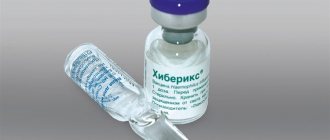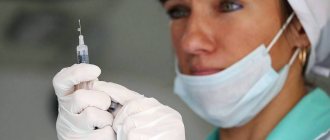When visiting a child care facility, in addition to acute respiratory viral infections and acute respiratory infections, a child is at risk of contracting an infection caused by the bacterium Haemophilus influenzae type b (Hemophilus influenzae type b), which provokes serious diseases:
- pneumonia;
- meningitis, otitis;
- osteomyelitis;
- nasopharyngitis;
- pericarditis;
- conjunctivitis;
- inflammation of the subcutaneous tissue;
- endocarditis.
At risk are children under five years of age and children with diseases that may reduce immunity. The disease caused by Haemophilus influenzae is widespread, which leads to a high risk of infection - 40% of children in the Russian Federation are carriers of this bacterium without showing symptoms of the disease.
Vaccination against hemophilus influenzae appeared in the vaccination calendar not so long ago, and therefore some parents refuse it as optional. However, it is necessary to remember the high risk of infection of a child if:
- visiting preschool institutions, development centers, playgrounds;
- the presence in the family of a child of school age and especially of preschool age (even in the absence of the disease, he can be a carrier of the bacterium);
- in the autumn-winter period, the risk of infection increases due to crowding of people in enclosed spaces
Pathologies resulting from Hib infection have a complex course and pose a danger to the child’s life.
Purulent bacterial meningitis (inflammation of the meninges) is the most severe form of the disease caused by this infection. This disease can only be diagnosed by examination by a doctor in a hospital setting.
Epiglottitis (inflammation of the epiglottis) is a dangerous disease with severe intoxication and croup, which develops rapidly and can cause fatal suffocation.
Hemophilic sepsis (blood poisoning) is typical for children from six months to the first year of life. It often progresses very quickly with septic shock and death.
Hib vaccines
Currently, the Hiberix vaccine is an innovative drug with proven safety and reliable protection of the child’s body, produced by a Belgian manufacturer in accordance with all standards of the World Health Organization.
The development of specific immunity occurs in 99 percent of cases of vaccine use, and revaccination ensures 100 percent production of antibodies against Haemophilus influenzae. The Hemophilus influenzae type b vaccine is registered in the prescribed manner and approved for use by the Russian Ministry of Health, and is administered to prevent diseases caused by Hemophilus influenzae in children aged 3 months to 5 years in accordance with the vaccination schedule determined by the doctor.
Vaccination against Haemophilus influenzae
Haemophilus influenzae infection - Haemophilus influenzae type B, Hib infection, Haemophilus influenzae type b (Hib) - hemophilus influenza - these are synonyms for the same infectious pathogen.
This bacterium affects only humans and is transmitted through airborne droplets (when talking, coughing, sneezing), as well as through shared objects (for example, toys).
Haemophilus influenzae is very difficult to cultivate in laboratory conditions; for this purpose, blood is added to the nutrient medium on which the microorganism is to be grown. Hence the name - hemophilic, that is, “loving blood.”
Haemophilus influenzae bacterium is widespread. In groups (for example, a kindergarten), 40% of children have this microbe “living” on the nasopharyngeal mucosa.
Haemophilus influenzae is the causative agent of various infectious processes: from common acute respiratory infections, bronchitis, otitis, to invasive forms: pneumonia, meningitis, sepsis. A disease caused by Hib is considered invasive when the pathogen is detected in tissues and body fluids that are normally sterile (blood, cerebrospinal fluid, abdominal fluid, lung fluid).
Children of the younger age group are most often affected, with the maximum incidence occurring before the age of 2 years.
Haemophilus influenzae type b has certain features - it is covered with a special capsule that protects it from the action of modern antibiotics. That is why, according to the WHO (World Health Organization): “Even with immediate and proper treatment with antibiotics, the mortality rate in patients with meningitis caused by Hib reaches 20%. Unfortunately, the percentage (30-40%) of neurological complications in this group of patients is also high.”
Children can repeatedly suffer from this infection in different forms.
At the same time, due to the unique structure of the microorganism, anti-infective protection (sufficient level of antibodies) is not formed even after an illness.
Vaccination against hemophilus influenzae protects the child, primarily from invasive forms of the disease (pneumonia, meningitis, etc.).
At the same time, studies have shown that thanks to vaccine prevention, Hib carriage is also significantly reduced, which, in turn, reduces the overall incidence of acute respiratory infections.
The vaccine against Haemophilus influenzae infection consists of elements of the bacterial capsule (capsular polysaccharide). That is, this is not a weakened microbe, and in no way can it develop a disease in the body.
According to the WHO, 2006: The Haemophilus influenzae vaccine does not cause any serious side effects. 25% of vaccinated people experience redness, swelling and pain at the injection site. This type of reaction usually occurs within 1 day after immunization and lasts 1-3 days. Less commonly, children may develop a fever or become agitated for a short period of time.
Vaccination against Haemophilus influenzae type B is possible either with a separate drug (for example, the drug Hiberix) or with a complex vaccine (for example, Pentaxim, Infanrix hexa).
A separate vaccine preparation creates anti-infective protection only against Haemophilus influenzae type B.
Combination drugs are used to prevent several infectious diseases.
For example, the drug Pentaxim forms immunity to five pathogens (whooping cough, diphtheria, tetanus, polio, hemophilus influenzae type B). Infanrix hexa is a six-component drug (whooping cough, diphtheria, tetanus, poliomyelitis, hepatitis B, Haemophilus influenzae type B).
The advantage of complex vaccines is that by creating protection against a number of infections at once, the number of injections a child needs to have is reduced, and this reduces discomfort and visits to the doctor.
It has been proven that the introduction of several antigens at once cannot negatively affect the child’s immune system. During the day, a child comes into contact with hundreds, if not thousands, of different microbes and viruses, and the introduction of five or six components will not negatively affect the baby’s immunity. An additional advantage of using complex vaccines is that the overall introduction of ballast substances is reduced.
All drugs are interchangeable, i.e. Having started a course of preventive vaccinations with a vaccine from one manufacturer, you can safely continue immunization with another drug.
Vaccination against Haemophilus influenzae is included in the routine vaccination calendar in more than 90 countries in various regions of the world; for example, in the UK, a high level of vaccination coverage against this pathogen has been maintained since 1992.
In our country, it is recommended to start preventive vaccinations against Haemophilus influenzae from the age of three months.
Your pediatrician will help you create an individual vaccination plan. The timing, number of administrations and choice of drug depend on what vaccinations the child already has, as well as on the characteristics of the child’s health condition and the region in which he lives.
Reasons why vaccination against Haemophilus influenzae is needed
- Hib is widespread
- Hib causes severe infectious diseases in children, most often under 2 years of age
- Hib is difficult to treat and is resistant to many antibiotics
- Hib – a child can get the infection repeatedly without developing sufficient immunity
- Hib vaccination is easily tolerated
- The introduction of a complex drug from Hib will reduce to a minimum the number of necessary manipulations and visits to the doctor
Vaccination schedules
In Russia, children are vaccinated against hemophilus influenzae according to an approved scheme, depending on the start date of vaccination:
- if vaccination started between 3 and 6 months, then three times at 3, 4.5 and 6 months. with revaccination at 18 months;
- if vaccination started between 6 months and 1 year, it is done 2 times with an interval of at least 2 months, revaccination is carried out at 18 months;
- If you are vaccinated at the age of over 1 year, the vaccine is administered once.
Children over five years of age are not vaccinated unless there are clear indications for this, determined by the attending physician.
After receiving the Hib vaccine, you can lead a normal life. You should also drink plenty of fluids and avoid introducing new foods into your child’s diet. No special preparation is required before vaccination. The child undergoes a pre-vaccination examination by a pediatrician. If the doctor identifies contraindications, vaccination is postponed. In the absence of contraindications, it is recommended to vaccinate all children under 5 years of age against Haemophilus influenzae.
Benefits of immunization in our clinics
High-quality vaccines
Vaccination against hemophilus influenzae in children is carried out with certified drugs that are absolutely safe for health: combined vaccines Pentaxim, Infanrix Hexxa, French conjugate vaccine Act-HIB, Belgian Hiberix.
High-quality prophylactic drugs do not undermine immunity or reduce the effectiveness of other vaccines, which allows them to be administered along with other vaccines. Combination drugs can prevent other infectious diseases (hepatitis B, mumps, meningitis, tetanus) in a timely manner.
Experienced staff
All NEARMEDIC specialists have undergone special training and have certificates confirming their qualifications. If parents are concerned about an allergy to the drug, you can consult an allergist-immunologist with us. After vaccination, the child is observed by a doctor for half an hour.
Features of vaccination against hemophilus influenzae infection
Since 2011, vaccination against Hib infection has been included in the National Immunization Calendar.
Effectiveness of vaccination
In 2000, before the widespread introduction of Hib vaccine in resource-limited countries, Hib disease accounted for 8.13 million cases of serious illness in children aged 1–59 months (range, 7.33–13.2 million cases). ) and 371,000 deaths (fluctuation amplitude – 247,000=527,000). By 2008, when 136 WHO Member States introduced the Haemophilus influenzae vaccine, there were an estimated 203 000 deaths due to Hib infection in children under 60 months of age (range 136 000–281 000).
The effectiveness of Hib vaccines is 95-100%; the protective antibody titer lasts for at least 4 years.
Among vaccinated people in 10 European countries, Israel and Australia, Hib infection developed with a frequency of only 2 cases per 1 million; 18% of these children had problems, including prematurity; 33% had low immunoglobulin levels.
Symptoms
The duration of the incubation period is difficult to determine, since the disease is often a consequence of the transition of a latent infection to a manifest one. Both a local inflammatory process of the mucous membrane of the upper respiratory tract and diseases caused by hematogenous dissemination can develop.
Complications after an illness
Often, hemophilus influenzae infection occurs in children in the form of a common respiratory infection with corresponding symptoms. However, cases of more severe forms of infection are not uncommon. The most severe form of Haemophilus influenzae infection is purulent meningitis. According to some data in Russia, in children under 6 years of age, up to a third of all cases of purulent meningitis are caused by Haemophilus influenzae type b. Haemophilus influenzae meningitis is difficult to treat because its causative agent produces enzymes that make it resistant to antibiotics (about 20-30% of Haemophilus influenzae bacilli isolated from patients are not sensitive to many antibiotics). Therefore, treatment results are not always successful, and mortality in severe forms of the disease can reach 16–20%.
A third of patients who have had hemophilic meningitis develop irreversible neurological complications - seizures, delayed neuropsychic development, deafness, blindness, etc.
Pneumonia caused by Haemophilus influenzae type b occurs predominantly in children aged 2 to 8 years, and its course in 60% of cases also has various complications, including those affecting the heart and lungs.
Up to half of all purulent infections of the ear, throat, and nose are associated with hemophilus influenzae infection, in particular, recurrent purulent otitis (inflammation of the middle ear) and sinusitis (inflammation of the paranasal sinuses).
Hemophilus influenzae sepsis most often develops in children 6-12 months of age who are predisposed to this disease. It proceeds violently, often like lightning, with septic shock and rapid death of the patient.
Purulent arthritis is a consequence of hematogenous introduction of Haemophilus influenzae and is often accompanied by osteomyelitis.
Safety and effectiveness
The course of immunization against Haemophilus influenzae consists of three doses. 1 month after the last dose, an antibody titer above the protective level is observed in more than 2/3 of vaccinated people. In the second year of life, a high level of protection is achieved in 99% of children.
Side effects are possible after the vaccine is administered. Fever occasionally develops. Some children experience swelling in one or both limbs. At the same time, there is redness, rash, and possible cyanosis. The child’s general condition worsens: irritability, nervousness, and severe crying appear. The appearance of these symptoms does not require treatment: they disappear within 24 hours without residual effects.
Because the vaccination is given at the same time as the tetanus shot, other side effects are possible. Sometimes local reactions occur at the injection site (pain, redness). The risk of side effects increases with each subsequent injection - most often such reactions are observed with the 4th or 5th injection of drugs. All phenomena resolve on their own within 3-5 days.
general information
Haemophilus influenzae infection is a series of acute infectious diseases caused by Haemophilus influenzae.
The pathogenic bacterium can cause diseases of the lungs and joints. The resulting pathologies can lead to serious deterioration in the child’s condition.
The causative agent is Haemophilus influenzae Afanasyev-Pfeiffer type B. It is a representative of the normal microflora of the respiratory mucosa. Quite often there is a healthy carriage of this pathogen.
The source of infection is sick people. These can be various diseases from acute respiratory infections to pneumonia. Infection occurs by airborne droplets.
When a patient sneezes or coughs, they release pathogenic bacteria into the air, which can be inhaled by a healthy person and become infected.
Vaccination experience
Experience shows that the ACT-HIB vaccine is well tolerated. Post-vaccination local reactions (usual, normal) in the form of pain, swelling and redness occur in no more than 10% of vaccinated people. Post-vaccination general reactions are rare - in 1-5% of vaccinated people - and manifest themselves in the form of short-term malaise, irritability or drowsiness, as well as a slight increase in body temperature. With repeated and joint vaccinations with DTP, the number and intensity of general and local reactions does not increase. Complications in the form of allergic reactions are extremely rare. Vaccination experience shows that a temporary contraindication to vaccination, as with all other vaccinations, is an acute infectious disease or exacerbation of a chronic disease. In this case, the vaccination is carried out 2-4 weeks after recovery. Immunoglobulin is a drug made from the blood of a person who has been ill or vaccinated against a particular infection and has developed antibodies - protective proteins against the causative agent of infection. A permanent contraindication is a severe allergic reaction to the components of the drug and complications that arose after previous administration.





